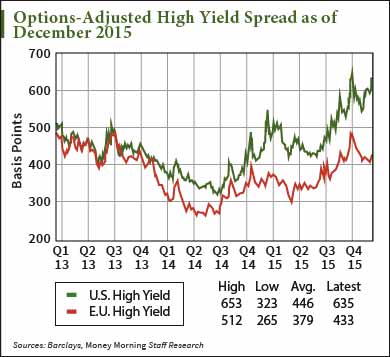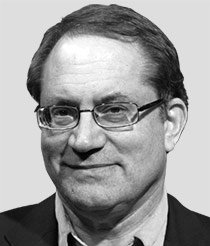Editor's Note: We're sharing this Sure Money with you today because here Michael shows you how one simple number on an easy-to-read chart tells you when to make your move to profit from this ongoing collapse. Here's Michael...
I'll be blunt: Don't believe the stock market gains we're seeing. They're not a sign of good times.
I've spent more than 20 years in the global credit markets, and from my position, I can see a destructive wave spreading out that will hit the stock market and scuttle the economy.
That's because the credit markets are a "canary in the coalmine." What happens there always spreads to the global markets.
The unprecedented $2 billion-plus collapse of popular high-yield funds that we're experiencing right now is just the start. Those billions are a drop in the bucket compared to the $200 trillion meltdown ahead.
But... the collapse of these funds, and the chart I'm about to show you, point to an immense opportunity - one where companies in desperate need of liquidity will come to you.
We're not there yet, so there's time to prepare, but this will be big...
How We Got Here
Last week, the $789 million Third Avenue Focused Credit Fund (MUTF: TFCVX) took a highly unusual step for a mutual fund.
It announced that it would liquidate and "gate" the fund, which means that investors would not be able to receive their money until the assets were sold at a later date. This move was necessitated by the fact that the fund (which is down 27% in 2015) owned many low quality and illiquid high-yield bonds that it was unable to sell. So, in order to accomplish this, the fund sold its assets into a liquidating trust and deemed the sale a redemption from the fund that met its obligation to redeem shares without asking the U.S. Securities and Exchange Commission (SEC) for prior approval to freeze withdrawals.
This is actually unprecedented.
Needless to say, this has "upset" investors and brought SEC examiners to its offices to figure out exactly what is going on. It has also freaked out investors in other high-yield bond funds, leading to a huge sell-off across the high-yield bond market.
It didn't stop with Third Avenue, either...
Another $400 million high-yield hedge fund managed by Stone Lion Capital Partners announced shortly thereafter that it was also gating its investors after receiving large redemption requests, and that another $900 million high-yield hedge fund managed by Lucidus Capital Partners had already liquidated and was returning all of its investors' capital.
Welcome to the downside of the U.S. Federal Reserve's invitation for investors to reach for yield - and greater risk!
How Third Avenue Really Messed Up
Third Avenue's Focused Credit Fund is an object lesson in mismatching an investment vehicle and the underlying investments that it owns.
[mmpazkzone name="in-story" network="9794" site="307044" id="137008" type="4"]
A mutual fund offers daily liquidity to its shareholders. It is required to do so by law. Yet this fund owned large positions in distressed and stressed credits that couldn't be easily sold in the best of market environments. In the current market, there is no chance that they can be sold at any reasonable price.
The fund peaked at $3.5 billion in 2014, but saw its performance and its assets deteriorate as the weakest sector of the high-yield bond market started coming apart in mid-2014 as commodity prices and China started leading the global economy downward. The flood of redemption requests and poor performance finally left it with no alternative but to close down and delay returning investors' money until it could sell the remaining assets.
But the real story is that these types of assets never should have been bought in a fund that promises to return money every day.
The same problem faces large high-yield bond exchange-traded funds (ETFs) that not only have to return money once a day, like a mutual fund, but during the day as well.
The largest ETFs, iShares iBoxx $ High Yield Corp. Bond ETF (NYSE Arca: HYG) and the SPDR Barclays Capital High Yield Bond ETF (NYSE Arca: JNK), have arranged credit lines and built up cash positions to weather the storm. But if the storm turns into a hurricane, they may experience similar pressures to Third Avenue.
Fortunately, these two ETFs are owned by Blackrock and State Street, two firms that have the financial wherewithal to step in if necessary to prop them up. But investors should not be investing in vehicles that promise what they can't deliver - and high-yield bond ETFs are promising to deliver daily or intraday liquidity from an asset class that trades by appointment if at all, especially at times of crisis like we are in now.
The demise of Third Avenue's Focused Credit Fund is unlikely to be the last mutual fund to experience a meltdown. Yahoo! Finance points out today that there are 28 more mutual funds, with $26.4 billion in assets, that are down 10% or more this year.
And it doesn't stop with mutual funds. Third Avenue will also undoubtedly be followed by many hedge funds that will be forced to gate their investors. Credit funds have not made money for several years and began to lose money in 2014, and lost more money in 2015.
Here's the Chart to Watch Now
The high-yield market is now a shambles. As of Tuesday morning, the average yield and spread on the Barclays High Yield index had blown out to 9% and 691 basis points, up by nearly 1% this month alone, and nearly 300 basis points in 2015.
 Many bonds have dropped in price by 10 points or more in the last week or so. But that doesn't tell the real story because it is virtually impossible to sell bonds at all, so their prices are very difficult to establish.
Many bonds have dropped in price by 10 points or more in the last week or so. But that doesn't tell the real story because it is virtually impossible to sell bonds at all, so their prices are very difficult to establish.
All you need to know is that things are bad and getting worse. The largest high-yield bond ETF, HYG, is trading lower than it did after Lehman Brothers went bust in 2009. And all of this is happening with the default rate still under 3%!
(In 2009, the default rate spiked over 10%. Wait until companies can't refinance their debt because their cost of capital has risen too high because of their depressed bond prices - the default rate will spike and the market will deteriorate even further. But that is a story for another day.)
The Opportunity: Wait for the High-Yield Spread to Plunge to 1,000
Large hedge funds, mutual funds, and ETFs stuffed with billions of dollars of these bonds are in for a miserable time over the next couple of years. Lower prices and illiquidity will raise the cost of capital for leveraged companies to levels that will force many of them into bankruptcy.
On the other hand, investors who can serve as liquidity providers over the next couple of years will make out like bandits.
The trick is this: Watch the average high-yield spread. You need to buy when the market is trading at distressed levels and sell when it is trading like everything is great.
What that means is when the average spread in high yield is under 600 basis points, there isn't much to buy. When it's over 1,000 basis points, there is stuff to buy. But you really want to wait until it's plunging wider like in 2009, when it was 2,500 basis points, and you could pick up dollars for $0.20.
You can make all of your returns in short bursts and then hide out the rest of the time in other investments. With the average high-yield spread at 691 yesterday morning, it's a bit too early. But investors are going to have to be patient, because the high-yield market is unlikely to really bottom until 2017.
The epic Debt Supercycle that began in 2009 with the Fed lowering rates to zero and keeping them there too long and then buying back trillions of dollars of debt is now coming apart at the seams. Investors may pray that the high-yield bond market collapse is the worst of it - though those prayers are unlikely to be answered.
Join the conversation! Follow Michael on Facebook and Twitter.
Michael will let his Sure Money readers know when to move on this opportunity - along with all the others coming from this "Super Crash." To get Sure Money for yourself, twice each week at no charge, click here. You'll also get an investor briefing with Michael's favorite way to buy and own gold.
About the Author
Prominent money manager. Has built top-ranked credit and hedge funds, managed billions for institutional and high-net-worth clients. 29-year career.



